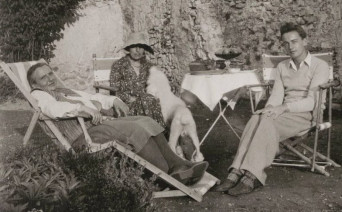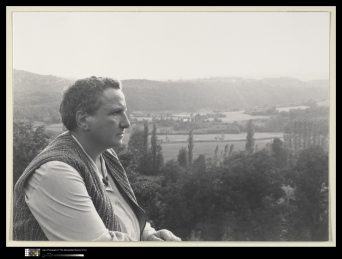by Michele Karlsberg
special to lesbian.com
“Gertrude In Clover Amiably”
The following excerpt traces a significant visit in June 1931 by the young photographer George Platt Lynes to the country home of Gertrude Stein and Alice B. Toklas in the provincial French town of Bilignin par Belley. Lynes had first been introduced to their famous Paris salon in 1925 at the tender age of eighteen; Stein had christened him “Baby George.” Now, he was anticipating his first two New York photography exhibitions and wished to have a formal portrait of Stein to display. He had maintained a personal correspondence with her over the intervening years, sharing the travails of a young man trying to get his professional footing in the world. His portrait of Stein overlooking the Rhone valley near her home would be cropped and serve as a Time magazine cover in 1934 when Stein and Toklas returned to America to publicize The Autobiography of Alice B. Toklas. Years later, in 1974, James R. Mellow published Charmed Circle: Gertrude Stein & Company, and used the Lynes portrait, similarly cropped, as its cover.

Fig. 1 Gertrude Stein, Alice B. Toklas, and George Platt Lynes, at the Stein-Toklas summer house in Bilignin, 1931 (photographer unknown). Gertrude Stein and Alice B. Toklas Papers, YCAL MSS 76. American Literature Collection, Beinecke Rare Book and Manuscript Library, Yale University, New Haven, CT.
Please enjoy the following excerpt:
George’s most consequential portrait that summer emerged from his visit with Gertrude Stein and Alice B. Toklas in the village of Bilignin at their leased seventeenth-century house “perched on a hill above a steep retaining wall . . . the perfect house, ample and old, with many windows, commanding a fine view across the valley.” It was east of Lyon not far from the Swiss border in verdant and hilly countryside. George had proposed a stay for the closing days of June. The women drove to pick him up at the station in Culoz, with their white poodle Basket in tow, and brought him back to their country abode. “[I] t was like a miniature château,” [Paul] Bowles wrote. “The walls were very thick, and inside the house it was beautifully quiet . .
If you went straight through the house, you came out into a garden ….”Bowles identified the two spots where George gives us visual testimony. One garden photograph was shot … near an ancient stone wall that bordered the property and prevented prying eyes from looking in (Fig. 1). The image shows the women and George at leisure; Basket presents his rear end with little puffed tail to the camera while nudging his face into Toklas. George, his hair brushed high off his forehead, wearing a pullover over an open-collar shirt … betrays a little smile; Alice, in a patterned dress, her eyes shaded by a sunhat, appears unyielding and dour. Gertrude, her corpulent figure sunken into a matching deck chair, smiles forthrightly back at the camera.
This image testifies to George’s status as one of the remaining few of that mostly homosexual coterie, expatriates from their native lands, who populated Stein’s salon in 1925, those whom she called la seconde famille. …
According to James Mellow, there was a “purge” that began “around 1930″. By 1932, however, she had divested herself of the circle of young men that had crowded her salon, courted her, sought her imprimatur, run errands for her. The means were various: Some were given such chilly receptions at the rue de Fleurus that it was clear their presence was no longer welcome; others were informed by curt notes of dismissal or by way of the telephone that had recently been installed.”

Fig. 2 Gertrude Stein, Bilignin, 1931. Gelatin silver print. Image: 11.4 × 15.7 cm 4612316×in.(). David Hunter McAlpin Fund, 1941. Image copyright The Metropolitan Museum of Art, NY. Image source: Art Resource, NY. Copyright Estate of George Platt Lynes.
And so, the Russian painter Pavel Tchelitchew and his lover, the American pianist Allen Tanner, the Russian painter and scenic designer Eugène Berman, and the French artist and designer Christian “Bébé” Bérard had all been dropped; meanwhile, the American writer Bravig Imbs was “briefly excommunicated” under suspicion of “influencing Thomson to take [poet George] Hugnet’s side” in his dispute with Stein.
George [Platt Lynes] was luckier. He had remained a devoted letter writer, seasoning his language with judicious flattery without seeming obsequious. He had certainly tried to help enlarge her reputation on the American side of the Atlantic and remained smitten by her every word— in private letters and public books— she ever wrote.
George set about photographing Stein and the commanding view from her property. He sat her on the low parapet of the garden … from which a panorama of the Rhône valley foregrounded a scrim of distant hills as backdrop to the scene (Fig.2). Stein on the picture’s left side sits solid as a Buddha. Her short greying hair is clipped so that it sits like a helmet close to her skull, the head of a Roman Caesar. The even silhouette of her face suggests, in its calm steady gaze, a quality of reflection of the external world or an introspection impressed with self-regard— after all, Stein knew she was being immortalized for posterity. She had been there and done that (posed for artists) numerous times before. She performed her role as lord and mistress of all that was seen from her perch to that distant hilly horizon.
Shortly later, he sent on a sampling of the Bilignin photographs:
Here is one set of the pictures. I am having three more sets made and will bring them to you when they are done …
The matter [of the photographs] stretched into autumn after George returned to the States. Writing “after so many months of silence,” he assured Stein he had “thought of you so often and of my lovely weekend with you . . . my days with you were the only really tranquil ones [that summer].” Recounting to Stein … his achievement of taking “between 1500 and 2000 photographs that summer,” he confessed that the unfinished business about the pictures taken at her country house had weighed on him since his return: Well, they are done at last and have been mailed . . . several required a grade of paper I can only get in this country, and that was my excuse to myself. Frankly I was very disappointed in them . . . But if you are glad to have even one or two, that is all I could ask.
[T]he subject herself … responded in early December, “We think the photos excellent and we are delighted to have them and showing them to everyone with pride and I have written to Carl [Van Vechten] to by all means see them and everybody likes enormously the profile of me against the view . . . and so you see it is a success, and I am pleased.” She sent fresh compliments soon after, when she wrote her “darling George”:
After all you are my friend George and in some way still the best beloved, and oh dear it would be nice if you were here. You would you know be my official photographer I do here by appoint you to this dignified post being a little fed up with Man Ray’s airs and graces but then of course I don’t pay but then on the other hand I do sell a little and you could sell me anyway in as much as I am I photographically speaking I am yours.
Being Stein’s “best beloved” could be an insecure position, but at least she was comparing him to other photographers and placing him high in her current pantheon. Still, he would have to wait to see the image of Stein’s profile “against the view” reach a large American public. The lasting outcome of the Stein portrait was yet in the future.
Excerpted from GEORGE PLATT LYNES: THE DARING EYE by Allen Ellenzweig






